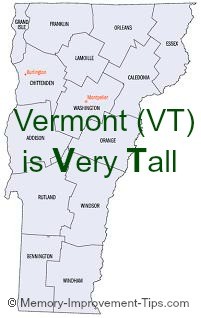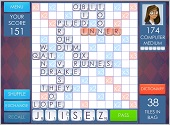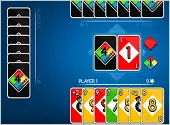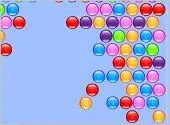- Home
- Better Memory
- Memory Systems
- Memorize Us Postal Codes
Memorize the US State Postal Codes

It's helpful to memorize the US state postal codes list, especially if you live in the US or communicate with people or businesses here.
Each state has a two-character postal code included in US mailing addresses for that state. For example, "FL" is the code for Florida.
There are 50 postal codes (listed below), one for each of the 50 states. But don't let the number of codes worry you. I'm about to share memory techniques with you that make remembering the list of codes easy and fun.
By the way, a state postal code is not the same as a ZIP code (ex., 70116) or state abbreviation (ex., Ariz., Conn., Fla.). There isn't much value in memorizing those, except perhaps your own.
Your friends and coworkers will be impressed if you know the US state postal codes, though. So, let's get memorizing!
Two Memory Aids: Patterns and Associations
Two powerful memory tricks for memorizing the 50 US state the postal codes are:
Identify patterns in the postal code list;
Create an association between the state name and its postal code. All you have to do is think up a silly, memorable sentence that links the sound of the state's name with the sound of the postal code. (For more on how this works, see the Best Memory Trick page.)
Below I'll show you exactly how to use these two methods to memorize the postal codes list.
Patterns in the US State Postal Code List
The first step is to look for patterns in the postal code list. Identifying a pattern can help you remember a selection of related facts, because it gives you a rule to follow.
To save time, I'll just tell you the patterns I found. But when studying other types of information on your own, be sure to actively search for patterns in the material.
Every state code begins with the first letter of the state's name.
Congratulations! By recognizing this pattern, you already know the first letter of all 50 states' postal codes. Now we need to memorize the second letter of each code. (That's harder.)
The second letter is found somewhere in the rest of the state's name. Sometimes it's the actual second letter of the name. In many cases, it's a middle letter or even the last letter. This pattern doesn't give you the codes, but it is a clue.
All states with two names use the first letter of each name as their code.
Two-name states are New Hampshire (NH), New Jersey (NJ), New Mexico (NM), New York (NY), North Carolina (NC), North Dakota (ND), Rhode Island (RI), South Carolina (SC), South Dakota (SD), and West Virginia (WV).
That's a valuable pattern. There are 10 states with 2 names, so by noticing this pattern you've instantly learned the state postal code for 10 out of the 50 states.
Associate with What You Know
Even with the help we got from the patterns, there's still plenty of room for confusion in the state postal code list. The problem is that many of the state codes don't follow an expected pattern (i.e., first letter of the name plus the second letter of the name).
That's why people get confused. They wrongly think Mississippi's code is "MI" because Mississippi's second letter is "I". But in fact "MI" is Michigan's code. Mississippi's is "MS".
You need a memory technique to ensure you don't get confused by tricky codes like those. Here is that powerful technique:
Create silly, memorable sentences (or mental images) that link the sound of the state's name with the sound of the state's postal code.
Because I'm a nice guy, I've done all the work for you. ![]() Below you'll find a silly, memorable sentence for each of the state postal codes.
Below you'll find a silly, memorable sentence for each of the state postal codes.
If this seems like a strange way to memorize, don't worry - you'll quicky notice these techniques are nothing more than creative and fun reminders of the actual postal code. After sufficient review, your true memory will take over and you'll just "know" the codes.
Silly, Memorable Sentences for Each Postal Code
As you read each of the silly sentences, try to visualize clearly in your mind what the sentence is describing. The clearer you see it, the more firmly your right-brain creative memory will anchor the state and its code together in your long-term memory.
INSTRUCTIONS. Words in italics represent the sound of the state's name. The bolded, all-capital letters are the state codes. Read every sentence several times, until the state and its code are clearly associated in your mind.
Alabama (AL). With a loud "bam!", I slammed down my glass of ALe.
Alaska (AK). You might need a yAK to climb the snowy mountains of Alaska.
Arizona (AZ). That airy zone includes every letter from A to Z.
Arkansas (AR). While building the Ark, Noah never waved his sharp saw in the AiR.
California (CA). Some Californians have four CAts.
Colorado (CO). My friend is a Commissioned Officer (CO) at the Air Force Academy in Colorado.
Connecticut (CT). The doctor connected the dots with a CT scan.
Delaware (DE). Beware of Dead Ends on the roads of Delaware.
Florida (FL). The floor is slippery, don't FaLl!
Georgia (GA). George, shut the GAte.
Hawaii (HI). The friendly Hawaiians always say HI.
Idaho (ID). Before hoeing the field, the farmer must show his ID.
Illinois (IL). I felt ILl (sick) when I visited Illinois.
Indiana (IN). To meet the Indian, go IN the tepee.
Iowa (IA). I owe BrIAn money.
Kansas (KS). KiSs a tin can for good luck.
Kentucky (KY). Tuck the KeY in your pocket.
Louisiana (LA). Louis sings LA, LA, LA on Bourbon Street.
Maine (ME). The lion's huge mane scared ME.
Maryland (MD). Mary's land is Mostly Desert.
Massachusetts (MA). That mass of gum, my MA chews it every day.
Michigan (MI). Mitch dropped his baseball MItt again.
Minnesota (MN). All MeN drink soda.
Mississippi (MS). He misses sipping his Milk Shake.
Missouri (MO). In misery, I MOw the vast lawn.
Montana (MT). On maps, MT means mountain.
Nebraska (NE). My neighbor asked if I hurt my kNEe.
Nevada (NV). Nevada is Not just Vegas.
New Hampshire (NH). *Follows two-name pattern
New Jersey (NJ). *Follows two-name pattern
New Mexico (NM). *Follows two-name pattern
New York (NY). *Follows two-name pattern
North Carolina (NC). *Follows two-name pattern
North Dakota (ND). *Follows two-name pattern
Ohio (OH). Oh, Hi, I'm Over Here!
Oklahoma (OK). Oklahoma is OKay.
Oregon (OR). All the OR is gone from the mine.
Pennsylvania (PA). My PA keeps dropping his pencil.
Rhode Island (RI). *Follows two-name pattern
South Carolina (SC). *Follows two-name pattern
South Dakota (SD). *Follows two-name pattern
Tennessee (TN). If you play tennis, you'll get a TaN.
Texas (TX). Texans pay high property TaXes.
Utah (UT). If you're tall, you won't fit Under There
Vermont (VT). Vermont is Very Tall, not wide.
Virginia (VA). Virgie drives a VAn.
Washington (WA). Washing a ton of clothes requires a lot of WAter.
West Virginia (WV). *Follows two-name pattern
Wisconsin (WI). Will's cousin is WIld.
Wyoming (WY). WhY did you break my Ming vase?
* Note: I have not provided memory tricks for the two-name states. As discussed in the Patterns section above, two-name states use the first letter of the first name and the first letter of their second name (for example, NC for North Carolina).
Postal Code for Washington D.C.
As you may know, the US capital is not located in any state. Washington D.C., also known as the District of Columbia, is a city outside of all state borders.
The capital does have a two-character postal code, though, which is DC. So Washington D.C. basically follows the two-name state rule.
Invest a Few Minutes to Master the Postal Code List!
As you study the state postal code list, keep the patterns in mind. Remember especially that for two-name states the first letter of the two names forms the postal code.
Now quiz yourself! Go to this list of the 50 states, and ask yourself the postal code for each state. When you think, "What is the state postal code for Kentucky?", KY should pop into your mind.
If it doesn't, inspect the name of the state for a clue: Ken-tuck-y. If you've practiced the silly sentences above, the "tuck" part of the state name should remind you to "Tuck the KeY in your pocket."
Using the silly sentences as mental hooks, you can fish the state postal codes out of your memory if you forget them. The silly sentences function as mental labels. As long as you've got a label, you can "look up" the associated fact in the filing cabinet of your memory.
Published: 09/03/2013
Last Updated: 06/11/2020

Newest / Popular
Multiplayer
Board Games
Card & Tile
Concentration
Math / Memory
Puzzles A-M
Puzzles N-Z
Time Mgmt
Word Games
- Retro Flash -
Also:
Bubble Pop
• Solitaire
• Tetris
Checkers
• Mahjong Tiles
•Typing
No sign-up or log-in needed. Just go to a game page and start playing! ![]()
Free Printable Puzzles:
Sudoku • Crosswords • Word Search















